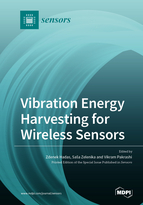Vibration Energy Harvesting for Wireless Sensors
A special issue of Sensors (ISSN 1424-8220). This special issue belongs to the section "Sensor Networks".
Deadline for manuscript submissions: closed (31 December 2021) | Viewed by 32775
Special Issue Editors
Interests: Vibration, Energy Harvesting Systems, Smart systems, Dynamics, Simulation and Modelling
Special Issues, Collections and Topics in MDPI journals
Interests: precision engineering, microsystems' technologies, structural analysis, mechatronics, compliant and energy harvesting devices, rehabilitation devices and measurement techniques
Interests: vibration; energy harvesting; structural health monitoring and control; smart materials and structures; dynamical systems; risk quantification and reliability analysis
Special Issues, Collections and Topics in MDPI journals
Special Issue Information
Dear Colleagues,
Mechanical vibrations occur in most technical systems in operation. High level vibrations could indicate an overloaded or damaged technical system; these states and behaviours can be monitored or reported. These ambient vibrations may be used as an autonomous source of energy; vibration energy harvesters could be an alternative for the supply of low-power electronic systems for remote sensing of operations. However, a level of harvested energy is usually very low and the whole concept of vibration energy harvesting system operations (including power management electronics and wireless sensors) must be adapted for target applications.
In this Special Issue, we invite you to submit contributions covering the area of vibration energy harvesting systems, power management electronics, and finally sensor systems with energy harvesters. This Special Issue aims to present papers that include the design and testing of vibration energy harvesters; development of materials and structures for vibration energy harvesting; model-based design of whole harvesting system; modelling, simulation, and optimization analysis; integration of energy harvesting systems; as well as experimental verifications and case studies. Contributions supported by experimental results are particularly welcomed.
Prof. Dr. Zdenek Hadas
Prof. Dr. Saša Zelenika
Prof. Dr. Vikram Pakrashi
Guest Editors
Manuscript Submission Information
Manuscripts should be submitted online at www.mdpi.com by registering and logging in to this website. Once you are registered, click here to go to the submission form. Manuscripts can be submitted until the deadline. All submissions that pass pre-check are peer-reviewed. Accepted papers will be published continuously in the journal (as soon as accepted) and will be listed together on the special issue website. Research articles, review articles as well as short communications are invited. For planned papers, a title and short abstract (about 100 words) can be sent to the Editorial Office for announcement on this website.
Submitted manuscripts should not have been published previously, nor be under consideration for publication elsewhere (except conference proceedings papers). All manuscripts are thoroughly refereed through a single-blind peer-review process. A guide for authors and other relevant information for submission of manuscripts is available on the Instructions for Authors page. Sensors is an international peer-reviewed open access semimonthly journal published by MDPI.
Please visit the Instructions for Authors page before submitting a manuscript. The Article Processing Charge (APC) for publication in this open access journal is 2600 CHF (Swiss Francs). Submitted papers should be well formatted and use good English. Authors may use MDPI's English editing service prior to publication or during author revisions.
Keywords
- Vibration
- Energy Harvesting System
- Electromagnetics
- Piezoelectrics
- Magnetostrictions
- Power Management Electronics
- Wireless Sensor
- Wireless Monitoring









